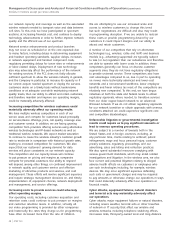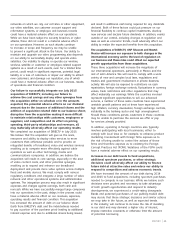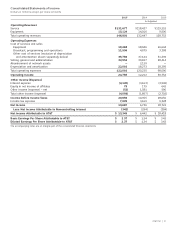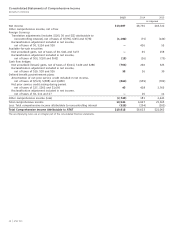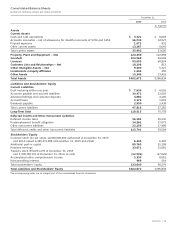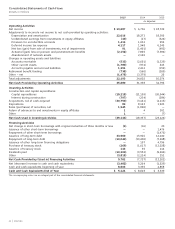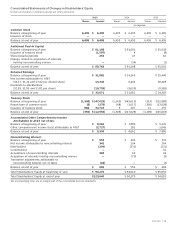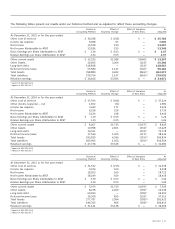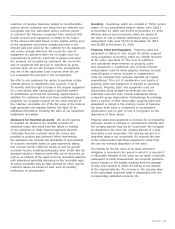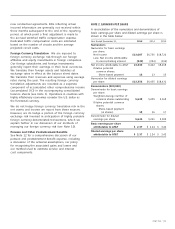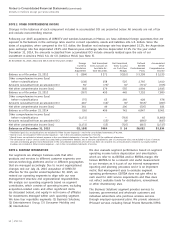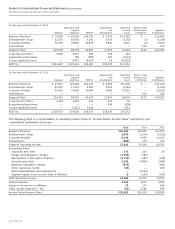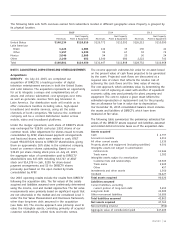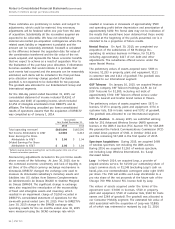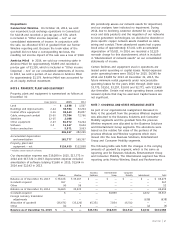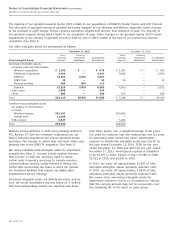AT&T Wireless 2015 Annual Report Download - page 50
Download and view the complete annual report
Please find page 50 of the 2015 AT&T Wireless annual report below. You can navigate through the pages in the report by either clicking on the pages listed below, or by using the keyword search tool below to find specific information within the annual report.
Notes to Consolidated Financial Statements (continued)
Dollars in millions except per share amounts
48
|
AT&T INC.
Financial Instruments In January 2016, the FASB issued
ASU No. 2016-01, “Financial Instruments – Overall (Subtopic
825-10): Recognition and Measurement of Financial Assets
and Financial Liabilities” (ASU 2016-01), which will require
us to record changes in the fair value of our equity
investments, except for those accounted for under the equity
method, in net income instead of in accumulated other
comprehensive income. ASU 2016-01 will become effective
for fiscal years and interim periods beginning after
December 15, 2017, and with the exception of certain
disclosure requirements, is not subject to early adoption.
Income Taxes We provide deferred income taxes for
temporary differences between the carrying amounts of
assets and liabilities for financial reporting purposes and
the computed tax basis of those assets and liabilities.
We provide valuation allowances against the deferred tax
assets (included, together with our deferred income tax
assets, as part of our reportable net deferred income tax
liabilities on our consolidated balance sheets), for which
the realization is uncertain. We review these items regularly
in light of changes in federal and state tax laws and
changes in our business.
Cash and Cash Equivalents Cash and cash equivalents
include all highly liquid investments with original
maturities of three months or less. The carrying amounts
approximate fair value. At December 31, 2015, we held
$2,117 in cash and $3,004 in money market funds and
other cash equivalents.
Revenue Recognition Revenues derived from wireless,
fixed telephone, data and video services are recognized
when services are provided. This is based upon either usage
(e.g., minutes of traffic/bytes of data processed), period of
time (e.g., monthly service fees) or other established fee
schedules. Our service revenues are billed either in advance,
arrears or are prepaid.
We record revenue reductions for estimated future
adjustments to customer accounts, other than bad debt
expense, at the time revenue is recognized based on
historical experience. Service revenues include billings
to our customers for various regulatory fees imposed on
us by governmental authorities. We report revenues from
transactions between us and our customers net of taxes
the government authorities require us to collect from
our customers in our consolidated statements of income.
Cash incentives given to customers are recorded as a
Revenue Recognition In May 2014, the FASB issued
ASU No. 2014-09, “Revenue from Contracts with Customers
(Topic 606)” (ASU 2014-09) and has since modified the
standard with ASU 2015-14, “Deferral of the Effective
Date.” These standards replace existing revenue recognition
rules with a comprehensive revenue measurement and
recognition standard and expanded disclosure requirements.
ASU 2014-09 becomes effective for annual reporting
periods beginning after December 15, 2017, at which point
we plan to adopt the standard. Upon initial evaluation,
we believe the key changes in the standard that impact
our revenue recognition relate to the allocation of contract
revenues between various services and equipment, and
the timing in which those revenues are recognized.
We are still in the process of determining the impact
on the timing of revenue recognition and the allocation
of revenue to products and segments.
ASU 2014-09 also specifies that all incremental costs of
obtaining and direct costs of fulfilling our contracts with
customers should be deferred and recognized over the
contract period or expected customer life. In the third quarter
of 2015, we changed our accounting policy for the costs of
fulfilling contracts with customers to defer all recoverable
costs while not changing our approach to acquisition costs.
We believe, as a result of our accounting policy change for
fulfillment costs, that the requirement to defer such costs in
the new standard will not result in a significant change to our
results. The requirement to defer contract acquisition costs
however, will result in the recognition of a deferred charge on
our balance sheets, but as the industry continues to undergo
changes in how devices and services are sold to customers
with impacts on the resulting commissions paid to our
internal and external salesforces, we cannot currently
estimate impact of this change.
The FASB allows two adoption methods under ASU 2014-09.
Under one method, a company will apply the rules to
contracts in all reporting periods presented, subject to
certain allowable exceptions. Under the other method, a
company will apply the rules to all contracts existing as of
January 1, 2018, recognizing in beginning retained earnings
an adjustment for the cumulative effect of the change and
provide additional disclosures comparing results to previous
rules. While we continue to evaluate the impact of the
new standard and available adoption methods, we believe
the standard will require us to implement new revenue
accounting systems and processes, which will significantly
change our internal controls over revenue recognition.
In addition, the implementation of the new systems and
processes will impact our considerations of which adoption
methods we intend to use.


